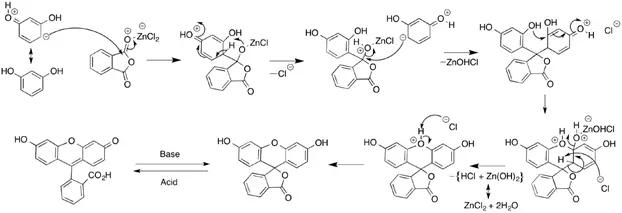[ps2id id=’background’ target=”/]
BACKGROUND
Principle:
Here a modified Friedel-crafts acylation reaction is occurring. This reaction is a series of electrophilic aromatic substitutions, with hydroxyl leaving groups picking up protons by Lewis acid catalysis. It increases the electrophilicity of pthalic anhydride in the first step, and facilitates the elimination of the hydroxyl groups. In order to get the form of the molecule shown as the product of the reaction, the pH needs to be increased in order to open the lactone ring.1
Aim: To prepare fluorescein from resorcinol and phthalic anhydride.
Reaction:

Mechanism:

Use:
It is a type of dye used in forensics and serology to detect latent blood stains and in dye tracing, also used for synthesis of dye, eosin.
[ps2id id=’requirements’ target=”/]
REQUIREMENTS
Chemicals: Phthalic anhydride
Resorcinol
Anhydrous zinc chloride
Concentrated hydrochloric acid
Sodium hydroxide
Apparatus: Conical flask
Beaker
Pipette
Glass rod
Buchner funnel
[ps2id id=’procedure’ target=”/]
PROCEDURE
Method 1: Taking anhydrous zinc chloride and concentrated hydrochloric acid.
Grind 15 g of phthalic anhydride and 22 g. of resorcinol together and transfer the mixture to a conical flask. Heat the flask on an oil bath to 180° (internal temperature). Weigh out rapidly 7 g. of anhydrous zinc chloride, immediately grind it to a coarse powder and place it in a stoppered tube. The zinc chloride should not be exposed to the air. Add the zinc chloride in small portions, with stirring by means of a thermometer, to the mixture in the flask. Continue heating at 180° with stirring at intervals of 2-3 min until the solution becomes so viscous that further stirring is not practicable (45-90 min). The resulting dark red mass consists largely of a mixture of fluorescein and zinc chloride together with basic zinc salts. Allow the oil bath to cool to about 90°, and add 200 ml. of water and 10 ml. of concentrated hydrochloric acid to the reaction mixture, and then raise the temperature of the oil bath until the water boils. Stir the mixture from time to time when the temperature of the oil rises above 110°, great care should be taken to prevent the dilute acid from boiling over. Continue the boiling until the reaction mixture has disintegrated and all the zinc salts have dissolved. Filter the insoluble residue of fluorescein at the pump, grind it with water in a mortar, and filter again. Dry at 100°. The yield is 30 g. The fluorescein may be purified by dissolving it in dilute sodium hydroxide solution, filtering if necessary, precipitating with dilute hydrochloric acid (1:1), filtering, washing and drying.
Method 2:
Taking conc. H2SO4 instead of anhydrous zinc chloride and conc. hydrochloric acid.
Take 0.2 g of phthalic anhydride, 0.3 g of resorcinol in dry conical flask. Add 6 drops of 4N H2SO4 and heat in a preheated oil bath to a temperature between 180° and 200°C for half an hour avoiding overheating. Cool the reaction mixture for 5 min. When the temperature is about 80° add 10 ml acetone and stir vigorously for 5- 10 min. The solution should turn yellow as the crude fluorescein dissolves. If the entire product did not dissolve, repeat the process with an additional 5 mL of acetone. Combine the acetone layers in a 50 mL beaker and Boil off the acetone leaving a crude orange residue. Dissolve the residue in 30 mL of diethyl ether and 1.5 ml of water.
Stirr for several min, separate the layers using separatory funnel adding 15 ml water and extract the ether layer once with 10 mL of a saturated NaCl solution. Pass the organic layer over anhydrous sodium sulfate and evaporate to dryness in a water bath.2-5
CALCULATION:
Here limiting reagent is phthalic anhydride; hence yield should be calculated from its amount.
Molecular formula of phthalic anhydride e = C8H4O3
Molecular formula of fluorescein = C20H12O5
Molecular weight of phthalic anhydride = 148 g/mole
Molecular weight of fluorescein = 332 g/mole
Theoretical yield:
148 g phthalic anhydride forms 332 g fluorescein
Therefore, 15 g phthalic anhydride will form …….? (X) g fluorescein
X =(332 ×15)/148 = 33.65 g
Theoretical yield = 33.65 g
Practical yield = ————- g
% Yield = (Practical Yield)/(Theoretical Yield) × 100
[ps2id id=’conclusion’ target=”/]
CONCLUSION
Fluorescein was synthesized and the percentage yield was found to be………..%
[ps2id id=’references’ target=”/][ps2id id=’1′ target=”/]
REFERENCES
-
Jag M. Organic Anlaytical Chemistry: Theory and Practice. 2003, Alpha Science ltd., Rohtak, India, p. 497.
-
Nencki IM, Sieber N. J Prakt Chem. 1881;23:147.
-
Stephenson CJ, Shimizu KD. Org Biomol Chem. 2010;8:1027-32.
-
Vogel’s Textbook of Practical Organic Chemistry by Brian S. Furniss, Antony J. Hannaford, Peter W. G. Smith & Austin R. Tatchell; Third Edition
-
Practical pharmaceutical chemistry by Anees Ahmed Siddiqui and Mohammed Ali, Publication year 2006, page no. 139.


